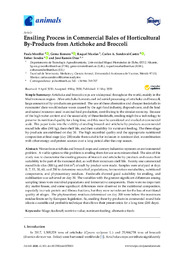Por favor, use este identificador para citar o enlazar este ítem:
https://hdl.handle.net/11000/34292Registro completo de metadatos
| Campo DC | Valor | Lengua/Idioma |
|---|---|---|
| dc.contributor.author | Monllor Guerra, Paula | - |
| dc.contributor.author | Romero, Gema | - |
| dc.contributor.author | Muelas, Raquel | - |
| dc.contributor.author | Sandoval-Castro, Carlos Alfredo | - |
| dc.contributor.author | Sendra, Esther | - |
| dc.contributor.author | DIAZ SANCHEZ, JOSE RAMON | - |
| dc.contributor.other | Departamentos de la UMH::Tecnología Agroalimentaria | es_ES |
| dc.date.accessioned | 2025-01-10T18:40:47Z | - |
| dc.date.available | 2025-01-10T18:40:47Z | - |
| dc.date.created | 2020-05-11 | - |
| dc.identifier.citation | Animals 2020, 10(5), 831 | es_ES |
| dc.identifier.issn | 2076-2615 | - |
| dc.identifier.uri | https://hdl.handle.net/11000/34292 | - |
| dc.description.abstract | Wastes from artichoke and broccoli crops and cannery industries represent an environmental problem. A viable option to this problem is ensiling them for use as ruminants feed. The aim of this study was to characterise the ensiling process of broccoli and artichoke by-products and assess their suitability to be part of the ruminant diet, as well their minimum shelf life. Twenty-one commercial round bale silos (300 kg and 0.64 m3) of each by-product were made. Samples were analysed at days 0, 7, 15, 30, 60, and 200 to determine microbial populations, fermentation metabolites, nutritional components, and phytosanitary residues. Feedstuffs showed good suitability for ensiling, and stabilisation was achieved on day 30. The variables with the greatest significant differences among sampling times were microbial populations and fermentative components. There were no important dry matter losses, and some significant differences were observed in the nutritional composition, especially in crude protein and fibrous fractions, but they were not relevant for the loss of nutritional quality of silages. The phytosanitary residues determined on day 200 were below the maximum residue limits set by European legislation. So, ensiling these by-products in commercial round bale silos is a suitable and profitable technique that allows their preservation for a long time (200 days) | es_ES |
| dc.format | application/pdf | es_ES |
| dc.format.extent | 15 | es_ES |
| dc.language.iso | eng | es_ES |
| dc.publisher | MDPI | es_ES |
| dc.rights | info:eu-repo/semantics/openAccess | es_ES |
| dc.rights | Attribution-NonCommercial-NoDerivatives 4.0 Internacional | * |
| dc.rights.uri | http://creativecommons.org/licenses/by-nc-nd/4.0/ | * |
| dc.subject | Silage | es_ES |
| dc.subject | Feedstuff | es_ES |
| dc.subject | Nutritive value | es_ES |
| dc.subject | Ruminant feeding | es_ES |
| dc.subject | Alternative feeds | es_ES |
| dc.title | Ensiling Process in Commercial Bales of Horticultural By-Products from Artichoke and Broccoli | es_ES |
| dc.type | info:eu-repo/semantics/article | es_ES |
| dc.relation.publisherversion | https://doi.org/10.3390/ani10050831 | es_ES |

Ver/Abrir:
Ensiling process in commercial bales of horticultural by-products from.pdf
1,69 MB
Adobe PDF
Compartir:
 La licencia se describe como: Atribución-NonComercial-NoDerivada 4.0 Internacional.
La licencia se describe como: Atribución-NonComercial-NoDerivada 4.0 Internacional.
.png)